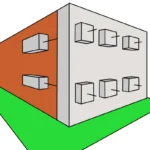What is a Metal Structure?

A metal structure is a system of elements and components primarily designed and constructed from metals, such as steel or aluminum, with the specific purpose of supporting loads, resisting forces, and providing stability in various construction and engineering applications. These structures consist of individual metal pieces, such as beams, columns, connectors, and reinforcements, strategically assembled to form an integral structure.
The choice of metallic materials is due to their key properties, such as mechanical strength, durability, and the ability to support heavy loads. Metal structures are highly valued for their versatility, allowing the design of a wide variety of shapes and sizes to meet the specific needs of each project. Moreover, their ability to be precisely manufactured in controlled environments, such as specialized factories, ensures consistent quality and rapid on-site installation.
Properties of Metal Structures
Metal structures possess several properties that make them fundamental elements in construction and engineering. These properties include:
Mechanical Strength: Metals, especially steel, excel in impressive mechanical strength. This means they can withstand considerable loads and resist stresses and deformations without compromising their integrity, making them ideal for constructions that need to support heavy loads.
Durability: Metals used in metal structures are inherently resistant to corrosion and deterioration, allowing them to maintain their robustness and reliability over time. This is crucial in outdoor or aggressive environments.
Versatility in Design: The malleability and ductility of metals allow a wide variety of architectural designs. This provides designers with great creative freedom, as metal structures can adopt different shapes and sizes.
Relative Weight: Despite their strength, metals are relatively light compared to other construction materials, such as concrete. This can result in a reduction in the total weight of a structure, leading to savings in transportation and foundation costs.
Ease of Fabrication: Metal pieces can be precisely manufactured in specialized facilities. This ensures uniform quality and the ability to produce complex components with tight tolerances. Additionally, it speeds up the on-site construction process.
Sustainability: Many metals used in metal structures are recyclable. At the end of a structure’s lifespan, metal materials can be recycled and reused in new applications, contributing to sustainability and reducing environmental impact.
Resistance to Extreme Conditions: Metal structures can withstand adverse weather conditions, such as strong winds, earthquakes, and temperature changes. This makes them suitable for various geographical locations and scenarios.
Advantages
Strength and Durability: Metals, such as steel, are known for their high strength and durability. Metal structures can support heavy loads and resist adverse weather conditions, making them ideal for industrial and commercial buildings.
Quick Construction: Metal structures are manufactured in factories and assembled on the construction site. This allows for faster construction compared to other building materials, reducing labor costs and accelerating delivery timelines.
Versatile Design: Metal structures are flexible in terms of design and can adapt to a variety of shapes and sizes. This allows architects and designers to create custom structures more easily.
Reduced Maintenance: Metals often require less maintenance compared to other building materials, such as wood, as they are resistant to pests, fungi, and rot. Additionally, painting and galvanizing finishes can provide additional corrosion protection.
Recyclability: Metals are highly recyclable, contributing to sustainability and waste reduction in construction. Recycled materials can be used to manufacture new metal structures.
Disadvantages
Initial Cost: Although metal structures may offer long-term savings due to their durability and low maintenance, the initial construction cost is often higher than that of other materials, such as wood or concrete.
Thermal and Acoustic Conductivity: Metals are good conductors of heat and sound, meaning that metal structures may be less energy-efficient in extreme climates and may require additional thermal and acoustic insulation measures.
Vulnerability to Corrosion: Despite protection against corrosion through galvanization or other coatings, metals can still corrode over time, especially in humid or salty environments. Proper maintenance is essential to prevent corrosion.
Difficulty in Modification: Metal structures are less flexible for later modifications compared to other materials, such as wood. Changing wall layouts or making additions can be more challenging.
Types of Metal Structures

Metal structures are widely used in construction and can be classified into various types based on their shape, function, and design.
Frame Structures: These structures consist of metal columns and beams forming a sturdy framework. Frames can be single or multi-story and are used in commercial, industrial, and office buildings. Multi-story steel buildings often use frame systems to support vertical loads.
Roof Structures: These structures are used to create roofs and coverings in a variety of buildings, from warehouses and hangars to stadiums and shopping centers. Metal roofs are known for their durability and ability to cover large spaces without the need for intermediate columns.
Portal Structures: Portal structures are similar to frames but have inclined legs instead of vertical columns. This allows the creation of large open spaces in industrial warehouses and buildings without the need for internal columns.
Truss Structures: These structures consist of a series of interconnected metal members forming a truss pattern. They are known for their efficiency in load distribution and are used in bridges, communication towers, cranes, and other projects requiring high strength with lightweight.
Arch Structures: Metal arches are used in bridges and roofing structures for stadiums and sports buildings. Arches can be simple or multiple and distribute loads evenly along their curved shape.
Cable Structures: These structures consist of tensioned steel cables supporting a structure, such as suspension bridges, observation towers, and fabric canopies. Cables provide stability and tensile strength.
Facade Structures: In modern buildings, metal structures are often used in the facade to create striking and functional architectural elements. This may include support structures for glass, cladding panels, and decorative elements.
Modular Structures: Modular metal structures are manufactured in factory prefabricated sections assembled on the construction site. This approach speeds up the construction process and is commonly used in commercial and residential buildings.
Reinforcement Structures: Metal structures are often used to reinforce existing buildings or bridges, providing additional support and extending their lifespan.
Conclusion
Metal structures are the backbone of modern construction and engineering. They consist of strategically assembled metal elements to support loads, resist forces, and provide stability in various applications. Their choice is based on key properties such as mechanical strength, durability, and the ability to support heavy loads, making them a valuable option for diverse projects.
These structures offer a range of advantages, including strength and durability, quick construction, design versatility, low maintenance, and recyclability, making them highly valued in the construction industry. However, they also present challenges, such as the initial cost, thermal and acoustic conductivity, vulnerability to corrosion, and difficulty in making later modifications.
Ultimately, the choice of a metal structure and its specific type depends on the needs and goals of each project, as well as economic and environmental considerations. Construction and engineering professionals must carefully evaluate these advantages and disadvantages to make informed decisions and create safe and functional structures that meet the required standards of quality and sustainability in the world of modern construction.







Related
What is Moment of Inertia in Engineering?
Reinforcement Steels
What Are Trusses? – Civil Engineering